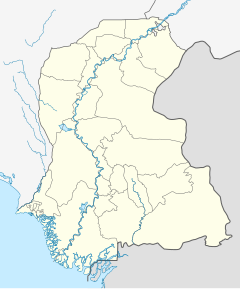Sri Chand Darbar or Baba Siri Chandar Temple is a 500 year old religious shrine dedicated to the Sri Chand, founder of Udasi sect and elder son of Guru Nanak. It is located in Faqir Jo Goth near Thatta city [1]
| Sri Chand Durbar | |
|---|---|
| Religion | |
| Affiliation | Hinduism |
| District | Thatta |
| Deity | Sri Chand |
| Location | |
| State | Sindh |
| Country | |
| Geographic coordinates | 24°44′53.88″N 67°57′49.68″E / 24.7483000°N 67.9638000°E |
History edit
Sri Chand travelled to Sindh in the second half of the 16th century during the reign of the Tarkhan dynasty and lighted dhuni at Faqir Jo Goth.[2] At that time, Thatta was under the rule of Mirza Baqi Baig, Tarkhan ruler of Sindh (1554–1591), who was infamous for his oppressive and tyrannical reign. Baba Siri Chandar bravely spoke out against the atrocities committed by Mirza Baqi.[1] The shrine was built at the place of dhuni to commemorate Sri Chand's visit.[3]
The shrine was also visited by Baba Bankhandi. After spending some time here before moving to Sadh Belo, which became his permanent abode, and where he spread the thought and ideology of Baba Srichand.[4]
Architecture and composition edit
The temple's stone architecture, features approximately 24 living quarters, a vast dining hall known as Bandharo, and expansive prayer rooms housing the idols. It was built 500 years ago on a sprawling two-acre site.[1]
In the courtyard, a 50-foot wooden flag adorned with colorful cloth, known as Jhando Sahib, was raised. Each year, on the 22nd day of Bhadun in the Hindi calendar, the Jhando Sahib was taken down and reinstalled by a Muslim family from Aamu Mallah.[1]
The shrine houses Granth Sahib, Bhagvad Gita, icons of all Sikh Gurus and portraits of Hindu deities.[3] Within the temple, there resides a 6-foot statue of Kanwar Bhagat, a revered mystic singer from Sindh. Tragically, he was assassinated during the pre-Partition violence while aboard a train near Ruk railway station, close to Sukkur.[1]
References edit
- ^ a b c d e "Shewadharis ready to die for saving historical temple". DAWN.COM. 2010-08-31. Retrieved 2024-04-12.
- ^ Kalhoro, Zulfiqar Ali (14 December 2018). "Udasi Sikh Saints of Sindh". Originally published on The Friday Times, republished on Academia.edu.
- ^ a b "Where the sacred fire is alight | Footloose | thenews.com.pk". www.thenews.com.pk. Retrieved 2024-04-12.
- ^ "Syncretic Sadh Belo". The Friday Times. 2017-12-29. Retrieved 2024-04-12.

